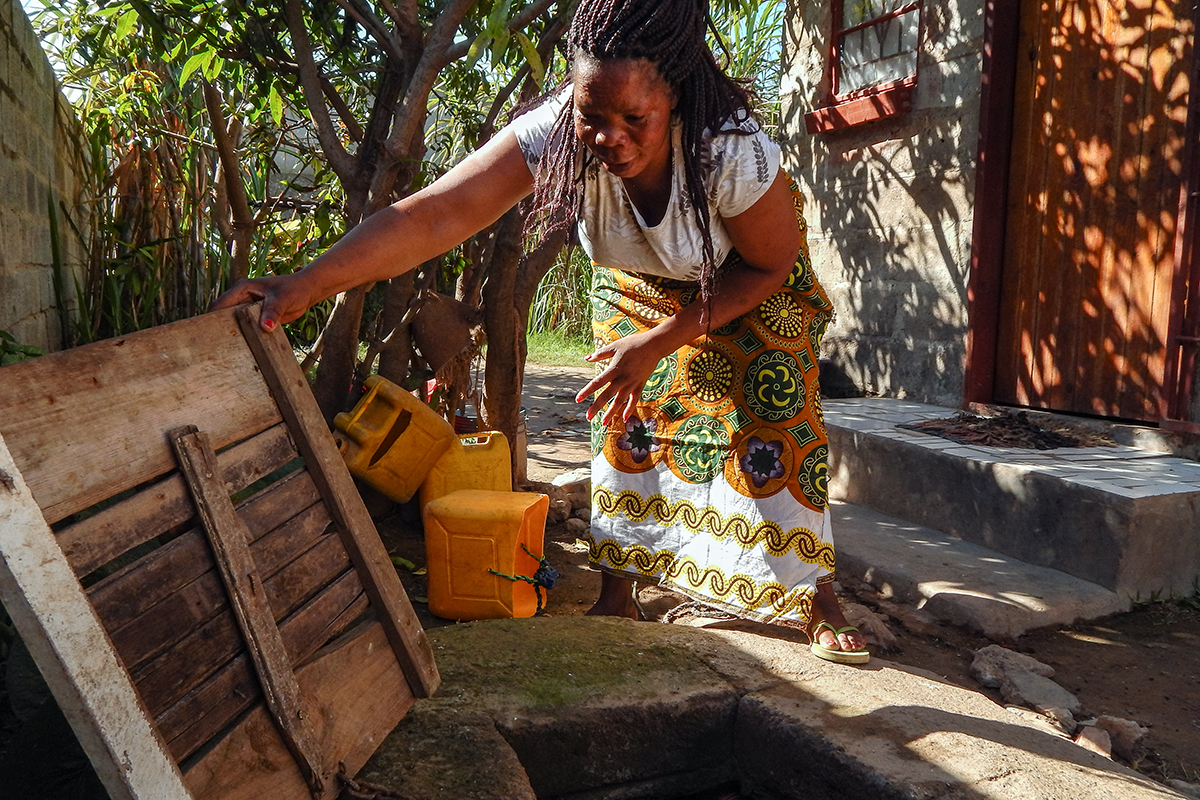
Prudence Phiri, GPJ Zambia
Agness Mwale draws water from a well to wash dishes. Mwale says her home has a tap, but water is never available through it. She buys bottles of water when she has the money, but otherwise drinks from the well, which she’s not certain is clean.
LUSAKA, ZAMBIA — Agness Mwale wakes up early, before her neighbors, to get water from the well they share. That water is used for washing, bathing and general cleaning, she says.
Later, she makes a trip to a communal tap, where she pays 0.5 Zambian kwacha (about 4 cents) for a 20-liter container of water, which she uses for drinking and cooking.
“I can’t afford to get all my water from the tap,” Mwale says. “It’s expensive.”
The Zambian government has allocated huge sums of money to improve sanitation and access to water across the country, but many say they still struggle to get what they need. According to WaterAid, an organization that works to provide clean water across the globe, the Zambian government releases less than half of the resources budgeted for water-supply and sanitation programs. Government officials say money meant for those programs is diverted to other critical sectors, including health and education.
In 2015, just 31 percent of Zambia’s 15.4 million people had basic sanitation services, according to UNICEF, the United Nations’ child-advocacy agency, and the most recent population statistics available.



Lack of access to clean water and sanitation became part of the national conversation again between October 2017 and May 2018, when about 5,900 people contracted cholera – mostly in Lusaka, the capital, according to the Centers for Disease Control and Prevention, a U.S. government agency. An estimated 114 people died.
In 2017, the government allocated 391 million kwacha ($32.7 million) to water supply and sanitation services, up from 283 million kwacha ($23.7 million) in 2016. The budget for that sector grew again in 2018, up to 564 million kwacha ($47.2 million). The 2019 budget includes 1.98 billion kwacha ($165.8 million) for water supply and sanitation. The total budget for the year is 86.8 billion kwacha ($7.2 billion).
Yet, in a trend going back nearly a decade, less than half of that money is spent each year on those services, says Pamela Chisanga, the WaterAid country director in Zambia. It’s not clear why the government holds back so much of the allocated money, she says.
“Water is a key sector that needs a 100 percent release of funds,” Chisanga says. “We can avoid calamities such as cholera if people have access to clean and safe water.”
Dennis Wanchinga, the minister of Water Development, Sanitation and Environmental Protection, doesn’t dispute that much of the money allocated for water supply and sanitation is spent elsewhere, but he notes that it’s not being wasted.
“That money is channeled to other pressing needs in other key sectors, such as education and health,” he says. “We have to compete for resources.”
He says his ministry will lobby the Ministry of Finance to receive the full water-supply and sanitation allocation in 2019.
While Wanchinga pushes for more money, some Zambians say they struggle to meet basic needs.
Mwale, the woman who pays for water at a community tap, says she sometimes can’t afford even that. On those days, she says, her family drinks from the neighborhood well, which she’s not convinced is clean.
Mary Phiri, another Zambian who faces daily water problems, knows how dangerous the consequences of water scarcity can be. Two years ago, she says, her daughter contracted cholera. She survived, but it’s no easier today to get clean water.
“Sometimes children would drink water from the well meant for washing dishes, because to them, water is water, whether from the well or from the tap,” Phiri says.
Prudence Phiri, GPJ, translated some interviews from Nyanja.
Editor’s note: Mary Phiri and Prudence Phiri, GPJ, are not related.







